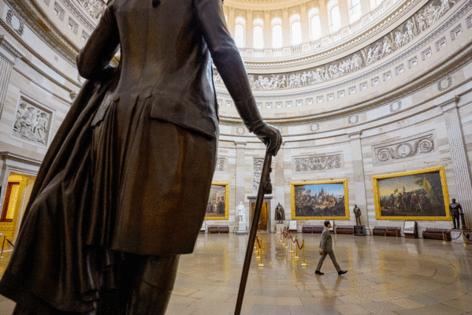Editorial: Washington ignores a looming fiscal emergency
Published in Op Eds
In its final report of the fiscal year, the U.S. Treasury Department delivered some unfortunate news. The government spent a little over $7 trillion in 2025 and raised just $5.2 trillion in taxes. To cover the gap, it borrowed $1.8 trillion, equivalent to more than a quarter of public spending and 6% of gross domestic product. “Unsustainable” is too mild a word.
Washington, preoccupied aptly enough with the latest government shutdown, has mostly looked away from this looming crisis. Before much longer, that option will no longer be available.
The Congressional Budget Office recently projected federal debt over the coming decades — assuming that current laws remain in place — and then asked what would change, given all-too-plausible variations around its customary baseline. It found that the ratio of debt to GDP, already at a postwar high of roughly 100%, is on track to exceed 150% over the next few decades. If the path of future interest rates is higher than assumed — increasing by 5 basis points a year — the debt ratio will exceed 200%. And if, instead of conforming to current law, revenue and spending maintain their historical averages (discretionary outlays of 7% of GDP and revenue equal to roughly 17% of GDP), the debt ratio will exceed 225% in 2050. (By 2055, it’s literally off the chart.)
Every signal is flashing red. Three of the main federal trust funds are close to insolvent. The Highway Trust Fund, financed with the tax on gas, will be empty by 2028. The Social Security retirement fund and the Medicare hospital-insurance fund, financed by income taxes, are both on course to run out in 2032. When the funds are depleted, the rules require the government to cut highway spending by 46%, Social Security retirement payments by 24% and Medicare payments by 12%.
Granted, if recent experience is any guide, Congress will simply waive those rules and let the debt keep on growing. In which case, sooner or later, lenders will question whether they’ll be repaid in full, and demand much higher interest rates to cover the risk. There’s already foreseeable pressure on future interest rates because of demographic stress (the ratio of dependents to workers is going up) and the need for extra investment in defense and clean energy. Add to that a sudden risk premium, and the economy finally hits the fiscal wall.
The budget gap is already so big that there’s no simple solution. Merely stabilizing the debt at 100% of GDP, never mind reducing it, would require cutting the deficit from $1.8 trillion to roughly $1.3 trillion – meaning tax increases and/or spending cuts to the tune of $500 billion a year (equivalent to a 10% tax increase across the board). And just stabilizing the debt isn’t good enough: Even at 100% of GDP, that would leave no fiscal space to deal with recessions and other emergencies.
Every year’s delay in addressing the problem makes it harder to solve. The White House and Congress must wake up to the gravity of the situation and start to think seriously about the mix of spending restraint and higher taxes that will be necessary to address it. Come to think of it, strike “seriously.” Giving the matter even a moment’s thought would be progress.
____
The Editorial Board publishes the views of the editors across a range of national and global affairs.
©2025 Bloomberg L.P. Visit bloomberg.com/opinion. Distributed by Tribune Content Agency, LLC.
























































Comments